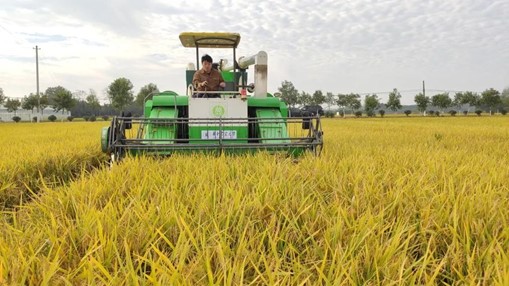Ratoon Rice refers to single-season rice with the secondary harvest that is realized through fast growth of dormant buds on the remained stubble after harvest of the first crop. As such kind of rice increases food production through enhancing harvest index, it plays an important role in safeguarding food security and increasing farmers’ income.

Ratoon rice is being reaped.
In recent years, with the rapid development of mechanized rice ratooning technology, the acreage of the rice has been growing. At present, it covers about 15 million mu (1 mu=0.0667 hectares). Ratooning ability (RA) is one of the most critical traits to determine ratoon yield. However, factors including lack of variants with strong RA, low and unstable ratoon yield heavily impede the further development of ratoon rice. There are few studies on gene cloning for RA, and the molecular mechanism that regulates RRA remains unclear.
Recently, a paper by Xiong Lizhong’s team from HZAU was published in Molecular Plant. The team cloned the world’s first rice ratooning ability gene-RRA3 and discovered the molecular mechanism involved in the regulation of RRA.
Through genome-wide association analysis, the study identified a candidate gene RRA3 which was significantly associated with several RA and ratoon yield traits. Pot and field phenotyping experiments demonstrated that compared with the wild-type Huang-hua-zhan (HHZ), the RRA3 knockout lines exhibited significantly higher RA and ratoon yield, while the overexpression lines showed a significant decrease in both.
RRA3 was found to encode a nucleoredoxin (NRX) protein with nuclear, cytoplasmic, and endoplasmic reticulum localization, and its expression was dramatically up-regulated in axillary buds 3 days after the first harvest. The results of biochemical experiments indicated that RRA3 could interact with the rice cytokinin (CK) receptor histidine kinases OHK4, OHK5, and OHK6 and inhibit the formation of dimers of OHK4 by reducing its intermolecular disulfide bond. This inhibition would ultimately lead to attenuated CK signaling and reduced RA.
In addition, variations in the promoter region of RRA3 led to differences in its expression, which in turn led to variations in RA. And introgression of a superior haplotype (Hap.1) with weak expression of RRA3 into Guichao2, a variety with weak RA significantly increased RA by 25% and ratoon yield by 23.8%, demonstrating the promising value of RRA3 haplotype (Hap.1) in ratoon rice breeding.
Xiong told the reporter of China Science Daily that RRA3 could negatively regulate RA by reducing the dimerization of the CK receptor OHK4 to attenuate CK signaling and affecting the expression of response genes downstream of CK. Therefore, it played an important role in the genetic improvement of strong RRA.
HZAU takes a leading role around the world in research on ratoon rice cultivation theories and technologies. Mechanized ratoon rice technology for improving grain yield developed by the university is applied in a large scale in Central China, making great contributions to food security.
相关论文链接:https://doi.org/10.1016/j.molp.2023.10.009
Source:http://news.hzau.edu.cn/2023/1103/68250.shtml
Translated by: He Fan
Proofread by: Fu Shipeng
Supervised by: Pan Buhan
